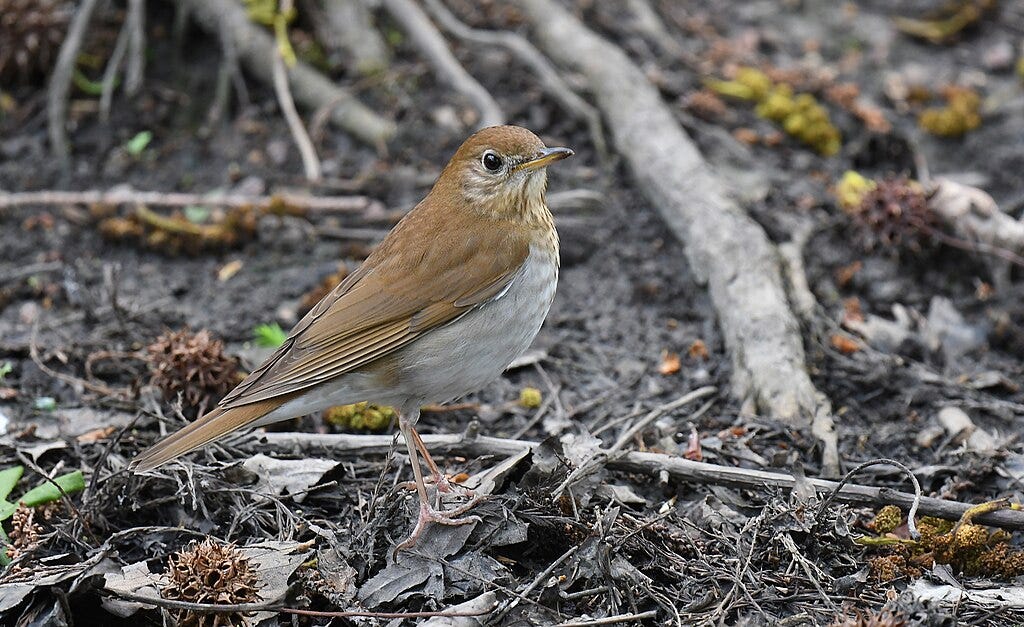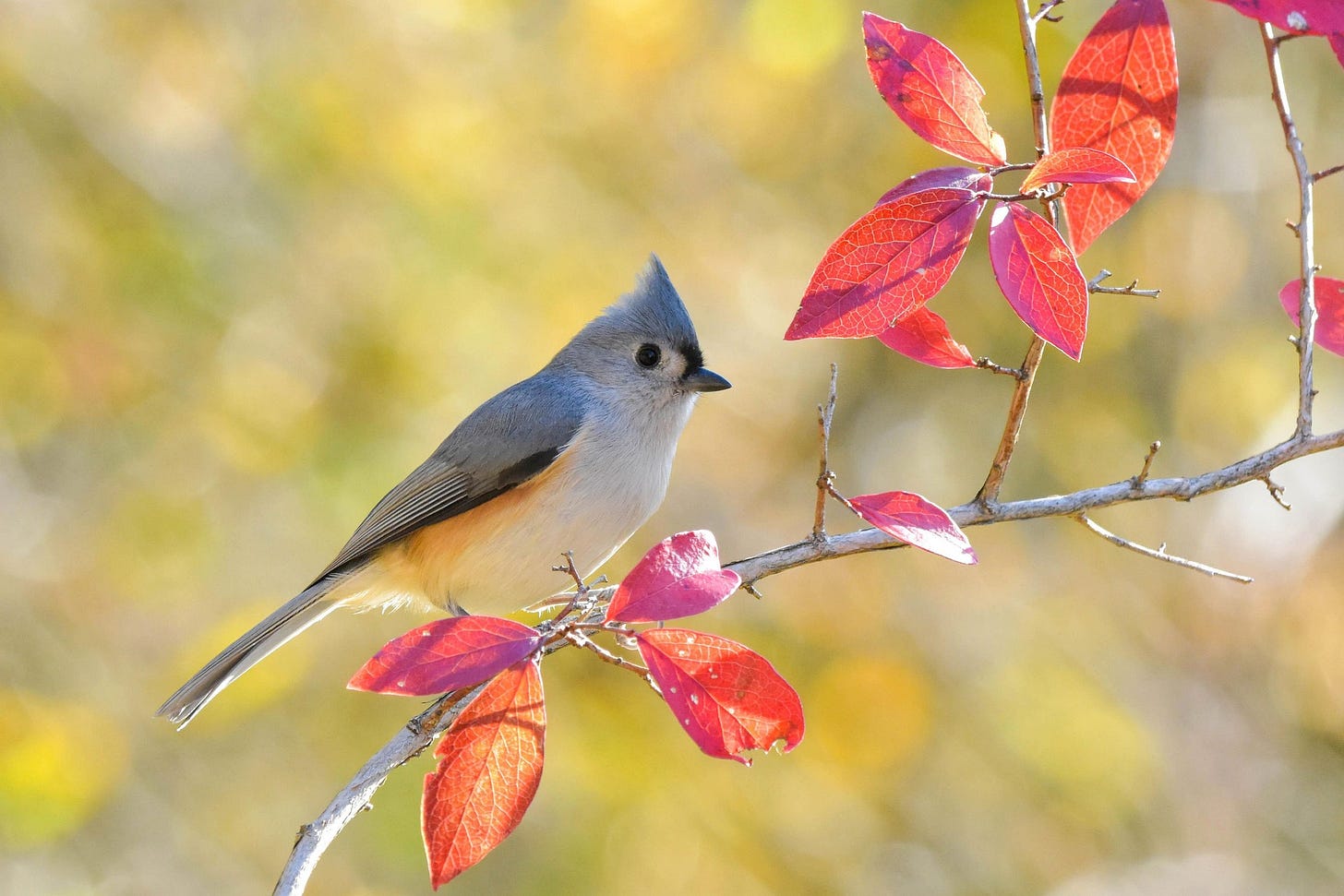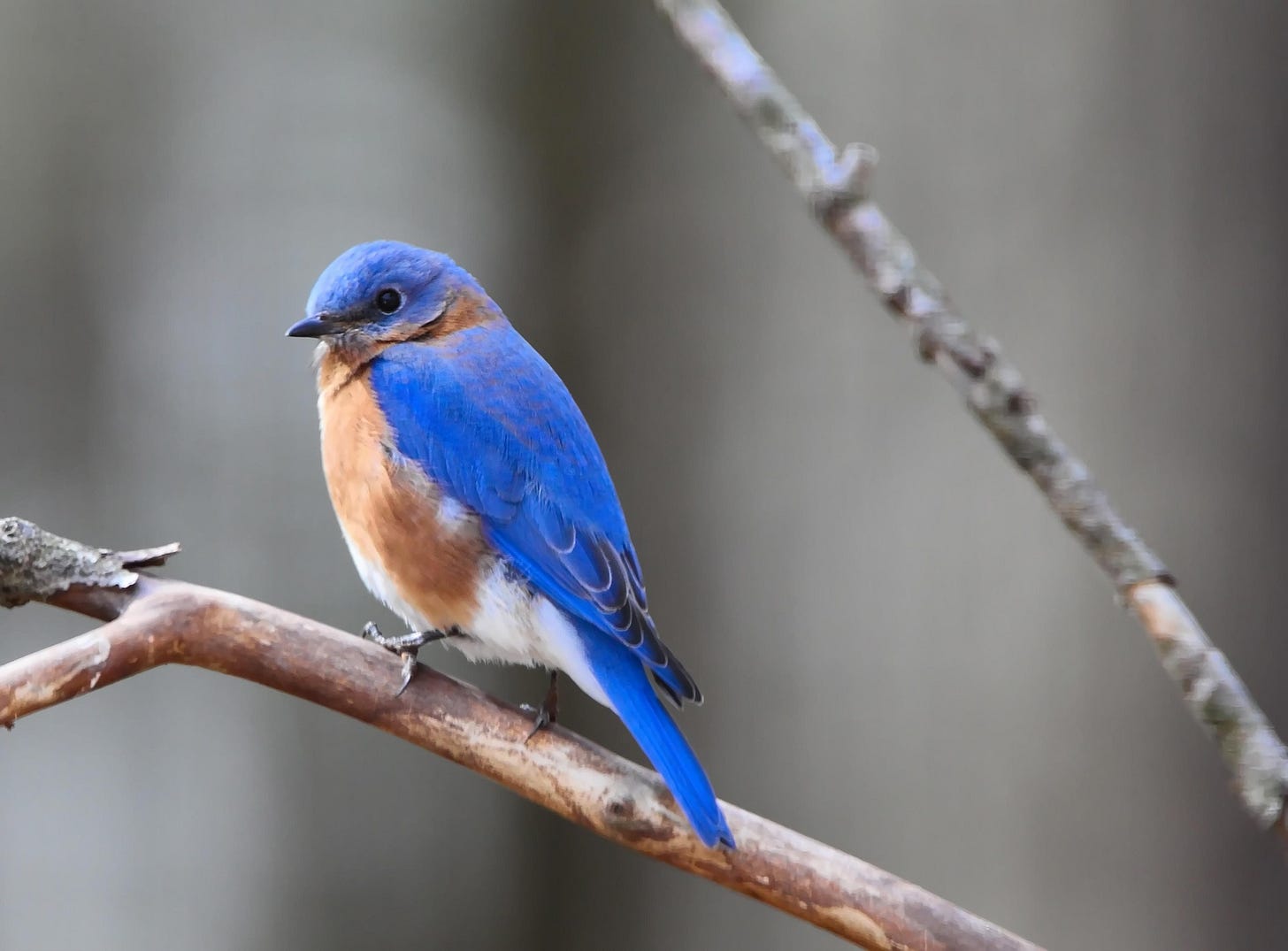The other day, a flash of orange caught my eye outside my window. Actually, that’s not what first caught my eye. First, I saw two — then three — rabbits, hopping across my neighbor’s yard. Rabbits are relatively common in this corner of Chicago, but not often so many all at once, and not often in my neighbor’s backyard.
It had rained that morning, and the grass was a rich, light green. The neighbors recently laid down fresh mulch next to the lawn. By August, that mulch will be gray and loose. But the sun hasn’t yet bleached its color, and it remains dark and firm. The rabbits were sidling along the mulch between this yard and the next, which are separated by a low wire fence with wide gaps, along which grows a loose collection of shrubs and ground-covering vegetation.
I’ve become used to this view over the past 11 months since moving in, and have now seen it almost entirely through the seasons. American robins are frequent visitors, as are house sparrows. In the winter, a handful of dark-eyed juncos seem to enjoy the big tree. Once, I saw a red-tailed hawk devouring what looked like the remains of a pigeon in that tree. Another time, I saw a fox sunning nearby (which I wrote about for this very newsletter). Recently, I’ve had the kitchen window open to let in the breeze, which has also let in the near-constant trill of the white-throated sparrow — oh, sweet Canada!
The point is, I’ve become used to the wildlife that frequents this little green square between the alley and the street. That’s why the flash of orange caught my eye.
It was a bird, about the same shape as a robin but maybe a little smaller. The orange on its back was not bright like the fruit but muted, halfway between orange and brown — but definitely at least halfway to orange. Its stomach was white, and I caught just a glimpse of its throat, which seemed like a more faded version of the orange on its back, before I dashed into the other room to grab my binoculars.
Immediately upon coming back to the window, however, I saw that the neighbors’ dog was also in the backyard. So was one of my neighbors, and the combination of dog and woman was enough to scare the bunnies across the fence. Within a few seconds, my neighbor and her dog had gone back inside (huzzah!), but as soon as they shut the door, the sky opened and rain started ricocheting off every leaf. My orange streak was now hiding.
The first time I noticed a bird was on a summer afternoon in college. I had taken a little solo hike up a mountain and picked up a copy of the Sibley Field Guide to the Birds of Eastern North America at the visitor center. I had always been interested in nature, and knew certain bird species, like a robin or a cardinal, even a barred owl. But up on that mountain, I saw a bird land on a branch and realized: I didn’t know what that bird was.
The thought came to me because, with my new field guide, I could figure out what that bird was. And once I knew there was a question to be asked, I had to find the answer.
Eventually, I discovered that my bird was a tufted titmouse. I came to this conclusion the way every birder does. You start to notice details about the bird, like how big it is or what color its feathers are. You look in the field guide and see something that could be your bird, but no, this bird in the book has some yellow on its head, and the one I’m looking at on the branch doesn’t have any yellow. Through trial and error, you look back and forth between the bird on the branch and the bird in your book, until — Aha! There it is! Tufted titmouse.
I had never seen a tufted titmouse, never even heard of it. But here it was, this whole new creature. Now, birds were no longer just a concept. Titmice were titmice, and they lived in my backyard. Robins were not simply robins but American robins, a type of thrush, related to the hermit thrush and the wood thrush. The forests were home to these birds, and more, like tanagers in the summer and warblers in the spring. Beaches were not just home to gulls, they were home to sandpipers, plovers, oystercatchers, terns, and many different species of gull. Bluebirds, a bird I had only ever considered in poetry or music, were real, and really blue!
As I learned more and practiced more, identifying birds came easier. Some, like a tufted titmouse, a common yellowthroat, or a great blue heron, I learned to identify on sight, even as they flew away 100 feet down the road. Other birds I learned to identify meticulously. Start with the shape: What does it look like? How big is it? Bigger or smaller than the bird next to it? What color is its back? Its wings? Its beak? Its legs? How is it flying? Is it in a tree, in a marsh, or on a rock?
But I haven’t always been the best birder. I don’t love getting out of bed before dawn on the weekend, and the early birder gets the early bird. I could have studied some of the more vexing birds a little more — don’t ask me about distinguishing among the tyrant flycatchers. My senior year of college, some friends and I had a competition to see who could spot the most bird species on our university’s campus. I saw plenty, but came in last place.
And in the last few years, in part because of the pandemic, I stopped going out to bird as much as I used to. In 2021, I wrote a story for Slate about this sudden lack of birds in my life, ending with the hope that I could find my way back to the joy birding once gave me. Four years later, I’m still not as bird-brained as I used to be.
But once you learn to see the world as a naturalist, that’s not something you can unsee. The other day, when the flash of orange skittered across my neighbor’s mulch, a word came to mind: Veery. I still know that a veery is a species of bird, vaguely brown-colored. I even remember that it has a distinctive “downward spiral” song. Was this flash of orange a veery?
When the rain slowed a few minutes later, I looked out the window again, binoculars in hand, hoping to glimpse my mystery. There was an American robin, there was a white-throated sparrow — and there, in the back, behind the fence!
Orange-brown back. Built like a thrush, but smaller than the robins. A lighter orange on the throat. I looked in the field guide, and there was no doubt: Veery.

My bird muscle memory isn’t perfect. Later that afternoon, I saw another bird in the backyard and thought: “Waterthrush!” I looked up both species of waterthrush — it wasn’t them. I perused the field guide a little more until I came across the ovenbird, a perfect match. Of course. Ovenbird. Once, I would have known that instinctively.
But “veery” had popped into my head from somewhere in the back where my brain had kept that knowledge for safekeeping. More importantly, the questions I learned to ask as a birder — how I learned to see after that day with the tufted titmouse — never went away. Looks like a thrush. Smaller than the robins. Brown-orange back, lighter throat, white belly.
This bird — this veery — likely just flew here from its wintering ground in Brazil. It’s related to robins, but more closely related to the Bicknell’s thrush and the gray-cheeked thrush. It eats insects and small fruits. It sings a spiraling trill, a melancholy song, but not quite so melancholy as its cousin, the hermit thrush. And, at least for a moment, maybe for a day, maybe a week, maybe until the juncos come back and tell us all that winter is on the way, it lives here.




